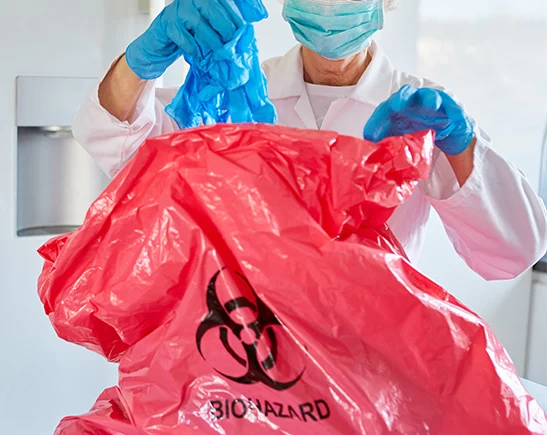Ecological Responsibility: The Eco-Friendly Technique to Medical Waste Disposal
Checking Out Different Waste Disposal Options for a Cleaner Environment
In the quest of a cleaner atmosphere, the management of waste disposal has emerged as a vital focal point for lasting growth. With a plethora of waste disposal choices readily available, ranging from standard land fill techniques to cutting-edge waste-to-energy modern technologies, the choice of just how we manage our waste has significant ramifications for our world's well-being.
Recycling Techniques
Carrying out efficient reusing techniques is important in decreasing waste and promoting sustainability in our setting. Recycling includes the process of converting waste products right into multiple-use challenge protect against unnecessary disposal. Among the most typical recycling methods is material healing, where products like paper, glass, steel, and plastic are accumulated, arranged, and refined to create brand-new products. This procedure not only saves all-natural resources yet additionally lowers power consumption and greenhouse gas exhausts connected with generating new products from the ground up.
One more crucial recycling technique is composting, which involves decaying organic waste like food scraps and yard trimmings into nutrient-rich dirt. By incorporating these numerous recycling techniques into our waste management methods, we can substantially lower our ecological impact and relocate towards an extra lasting future.

Composting Techniques
Efficient waste administration methods, such as recycling techniques, lead the way for a cleaner environment, and now, changing the focus to 'Composting Techniques', we explore sustainable methods to disintegrate natural waste for ecological advantage. medical waste removal service.
Composting is a natural procedure that transforms natural waste, like food scraps and lawn trimmings, right into a nutrient-rich soil amendment. The secret to successful composting hinges on producing the best equilibrium of green materials, such as fruit and vegetable scraps, and brownish products, like dried out leaves and twigs. These products decompose with the aid of microbes, damaging down the waste into important compost.
Traditional yard composting includes layering organic products in a bin or stack and consistently turning the combination to freshen it. By making use of composting strategies, we can lower the amount of waste sent to landfills while producing a valuable product for enriching dirt and sustaining plant development.
Incineration Disadvantages and pros
Incineration, as a garbage disposal technique, offers both advantages and disadvantages that merit cautious consideration in the world of lasting waste monitoring techniques. On the positive side, incineration can considerably decrease the volume of waste, minimizing the demand for land fill area and potentially decreasing greenhouse gas emissions. Incineration additionally permits the recovery of power through the generation of electrical energy or warmth, adding to resource recuperation. Furthermore, the procedure can be used to destroy dangerous materials, supplying a secure approach for managing particular kinds of waste that may pose threats to public wellness and the environment if left without treatment.
However, there are notable drawbacks to incineration. One major worry is the prospective release of hazardous toxins right into the air, such as dioxins, hefty steels, and particulate issue, which can have negative effects on human health and wellness and the atmosphere. In addition, the high preliminary financial investment and operational expenses of incineration centers posture financial obstacles, making it a much less cost-effective choice contrasted to other waste monitoring strategies. Mindful monitoring and policy are important to alleviate these adverse impacts and maximize the advantages of incineration as part of a detailed waste management method.
Garbage Dump Administration Approaches
Land fills play a vital function in waste administration and ecological conservation by providing a control system for the disposal of strong waste materials. By condensing the waste, the quantity is decreased, enabling for even more waste to be fit over time.
Furthermore, the application of daily cover methods is vital in lessening smells, protecting against litter, and decreasing the attraction of pests. Covering the disposed waste at the end of daily aids to contain odors and protect against possible environmental contamination. In addition, the surveillance of landfill gas discharges and leachate levels is important in ensuring that environmental criteria are met which any kind of potential threats to surrounding communities are lessened.

Waste-to-Energy Technologies
One of the cutting-edge strategies to throw away administration involves harnessing Waste-to-Energy innovations to convert strong waste right into functional power resources. Waste-to-Energy (WtE) technologies encompass a variety of processes that intend to remove energy from waste materials through thermal, chemical, or biological methods. This conversion process not only reduces the quantity of waste that winds up in landfills but see this here likewise generates valuable power sources such as electrical power, warmth, or biofuels.
Incineration involves shedding waste at high temperatures to create heat and electrical power. Gasification transforms waste into a syngas, which can be utilized for power generation or chemical production.
Executing Waste-to-Energy modern technologies can help reduce ecological issues connected with typical waste disposal approaches while all at once supplying a renewable resource resource. Nonetheless, careful consideration must be provided to exhausts control and making certain the sustainability of feedstock materials for these innovations to be truly advantageous for a cleaner setting.

Verdict
In final thought, discovering numerous waste disposal options such as reusing, composting, incineration, land fill administration, and waste-to-energy modern technologies is important for promoting a cleaner atmosphere - click here. Each technique has its very own benefits and difficulties, but by making use of a mix of these methods, we can work towards minimizing the amount of waste that winds up in land fills and ultimately add to a more sustainable future for generations to find
With a plethora of waste disposal alternatives readily available, varying from typical landfill techniques to cutting-edge waste-to-energy innovations, the choice of just how we handle our waste has significant implications for our earth's wellness. medical waste removal.Incineration, as a waste disposal method, provides both benefits and downsides that merit cautious consideration in the realm of lasting waste administration practices.Land fills play a crucial role in waste administration and ecological preservation by offering a containment system for the disposal of strong waste materials. By condensing the waste, the quantity is lowered, enabling for even more waste to be fit over time
One of the ingenious methods to squander management entails utilizing Waste-to-Energy modern technologies to convert solid waste into functional energy sources.